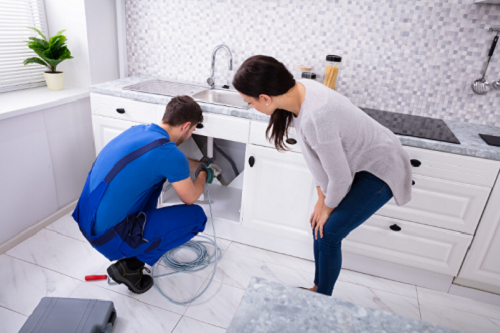Whether in the kitchen or bathroom, the sink drain plays a vital role in effectively disposing of wastewater. Since this place is always busy and damp, there might be drain buildup from everyday activities. Things like lotion, shaving cream, soap, hair, skin cells, and toothpaste can collect in drain pipes, creating a suitable environment for bacteria to thrive. Occasionally, you might be dealing with white slime in your sink drain.
If you’ve ever encountered slime in your sink drain, you know how unsightly it can be. You have to devise ways to remove and prevent the occurrence of this buildup. Keep reading to understand how to deal with white slime in the sink drain.
What Is the White Gunk in My Sink Drain?
The white waxy gunk in your pipes, sink drain, or plumbing fixtures is a buildup that develops due to various reasons.
First, it could be fats, grease, or oil being dumped down the drains. It could also be minerals in hard water, including magnesium, sodium, and other chemicals.
The white slimy stuff can also occur as a biofilm, a mixture of moisture-loving bacteria and mucous-like stuff. Biofilm bacteria have cells that help micro-organisms attach to your plumbing pipes, drains, and other surfaces.
Why Is There Slime in My Drain?
As mentioned above, your sink drain is ever damp. It is, therefore, not big news to find mold, bacteria, and other unpleasant stuff growing in there.
Let’s look at some of the reasons for slime in your drain in detail.
Detergent or Soap Deposits & Clogs
The white waxy clogging deposits you see in your drain sink, pipes, and effluent or sewage pumps could be caused by soaps or detergents washed down the sewer line.
The excess powdered detergent used in dishwashers or washing machines could be the reason for white waxy deposits in the drain. Some waxy blockages or clogs could also be due to bar soaps ending up in plumbing systems.
Biofilm or Bio-Slime Bacterial Growth
Some slime deposits in your sink drain could result from fungal growth like yeasts, bacterial growth, and other organisms growing in the drain.
Several factors could favor the formation of biofilm in water distribution systems. They include incorrect use of disinfectants, the ability of bacteria to repel disinfectants, and the concentration and nature of biodegradable materials, plumbing substances, and temperature.
Oils and Fats
Fats and oils also enter the pump chamber or drain system, where they consolidate to form gray, black, brown, tan, or white deposits.
It is advisable to avoid pouring oils and grease into the drains. Still, the fats and oils that accumulate on dishes from everyday consumption of different foods will end up in the drain system from the dishwasher or kitchen sink.
Mineral Scale Formation
Hard water or water high in magnesium or calcium may combine with different types of soaps to form waxy white stuff that clogs drains, septic pumps, and traps.
How Do I Get Rid of Slime in My Sink Drain?
The sink is one of the essential components in a home, and it is bound to be in use every other time. That means the abovementioned things are more likely to form in your sink drain, no matter how clean you are.
If you have slime in your sink drain, you must find ways to get rid of it for hygienic and health reasons.
Let’s discuss some of the ways to get rid of slime in your sink drain.
Wash It Off with A Cleaning Product
We have seen that bacterial growth is one of the reasons for the slimy stuff that clogs the drain trap, drain line, or ejector pump.
If that is the case, a simple household disinfectant or cleaner such as bioclean will do the trick of removing the bacteria.
Enzyme cleaners, vinegar, and drain cleaners do an excellent job of removing common bacterial slime clogs and deposits.
For residential drains with oil or fat clogging deposits, you can use plumbing drain FOG degreasers like Cloroben PT-4 to dissolve the clog.
For moderate-scale deposits, you can pour vinegar into the sewage pump or trap and give it a few hours to soften and dissolve the clog.
Clean Regularly
When your sink drain becomes clogged, you’ll likely reach for a strong bleach to clean it out. But you don’t want to be bleaching your drain every day. That’s why regular cleaning of the drain line is necessary to avoid dirt buildup that would require something strong to remove.
Always spray a little cleaner every other day to keep things friendly. You can also use milder bleaches such as chlorox.
Reduce the Amount of Food Available to the Bacteria
The bacteria in the drain will keep growing when food is available. You can reduce its growth by reducing the amount of food that goes down the drain. And this is not just ‘real’ food alone but also things like hair spray, shampoo, deodorants, and soaps, among other things.
Also, always flush down whatever you put down in the drain with a mild cleaner or water to make the environment more hostile to fungal and bacterial growth.
Remove Limescale
White slime uses limescale-coated drain pipes for grip, which helps them grow much faster. When you remove the limescale, the bio slime will find it much harder to take root, and it will also make it easier for you to clean.
To take off the limescale, make a mixture of clear/white vinegar, sodium bicarbonate (baking soda), and a regular cleaner. Use the solution to loosen the limescale before scrubbing it off.
Change Plumbing Fixtures
Certain materials used to make plumbing fixtures around the kitchen and bathroom sinks, such as rubber washers, tend to make white slime thrive more.
You can consider changing to alternative materials that are less friendly to bacteria, including cork, silicone rubber, neoprene sponge, ceramic, and neoprene rubber.
Can Bacteria in the Sink Drain Make You Sick?
Not only is biofilm (a collection of bacteria and mucous-like stuff) disgusting to the touch, smelly, and unsightly, but it can also affect your health. While it’s not a common occurrence, it’s possible to contract a severe illness from plumbing issues.
Biofilms have been associated with ailments such as Listeria, E. coli, ear infections, Salmonella, and MRSA.
You have a higher chance of catching any of these illnesses in the kitchen than in the bathroom. This is because the kitchen is where you’re handling more disease vectors. Things like raw chicken can disperse bacteria that can grow and thrive in your fixtures.
Take note that biofilms aren’t only limited to plumbing fixtures. They can be found on dish towels, cutting boards, counters, and any other damp surfaces that aren’t disinfected and dried properly.
That’s why it’s advisable to be more hygienic in your laundry room, kitchen, bathroom, and any other place that gets damp more often.
Final Thoughts on White Slime in Sink Drain
White waxy slime in sink drains is often caused by fats, grease, and oil deposits. It can also be caused by soap!
Having white slime in your sink drain is unsightly and can pose serious health risks to you and your family. It can also clog your sink and render it ineffective.
Therefore, ensure you get rid of this slime as soon as you notice it. A simple enzyme drain cleaner is enough to do the job, but mechanical cleaning is needed for thick clogs. If you have tried all the cleaning with little success, you’ll have to call a plumber. The plumber is knowledgeable and will assess and deal with the situation.



You have a very engaging writing style, and I love what you have to say. Maybe you could add a bit more content to help readers connect with your message even more.
Thank you so much for your comment, Curtis. I will definately look into that. Again, thank you.